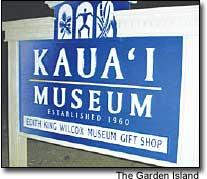LIHU‘E — The Kaua‘i Museum will become a larger vault for Kaua‘i’s history. Members of the Kaua‘i County Planning Commission, who met recently at the Lihu‘e Civic Center, approved plans proposed by members of the Kaua‘i Museum Association for a
LIHU‘E — The Kaua‘i Museum will become a larger vault for Kaua‘i’s history.
Members of the Kaua‘i County Planning Commission, who met recently at the Lihu‘e Civic Center, approved plans proposed by members of the Kaua‘i Museum Association for a new gift shop and an office wing on the grounds of the historic museum located at the intersection of Rice and ‘Eiwa street in Lihu‘e.
The museum features displays and information on the evolution of Hawai‘i, from ancient to contemporary times.
Museum exhibits chronicle the history of members of ethnic groups who came to Kaua‘i to work in Hawai‘i’s sugar industry, and recognize their contributions in the development of the island. In the same way, leaders of the Kaua‘i Historical Society, whose paid staff and volunteers operate out of a portion of the first floor of the two-story historic County Building, serve as keepers of the island’s history.
The Kaua‘i Museum comprises two buildings, the first being the Wilcox Building, designed by Hart Wood in 1922, and the second being the Rice Building, which was designed by Merill Simms and Roehrig Architects in 1958, according to museum plans sent to the planning commissioners and county planners.
Museum leaders have plans to build a new, 584-square-foot gift shop that will be attached to the existing Rice Building.
In addition, a 584-square-foot office wing will be built in the museum’s courtyard. The existing gift shop, which occupies 424 square feet in the Wilcox Building, will be relocated into the new addition.
Office space is currently found in both museum buildings, and although plans may call for the relocation of office functions off the museum grounds one day, office space will continue to be used, according to museum plans.
In addition, office functions could be relocated to the office wing if they are found to be essential for daily museum operations, museum leaders said in documents.
The Wilcox Building is a classic gable structure fitted with arched windows and a temple facade, while the Rice Building is a modernistic box.
The design of the new addition will be different from that of either building. The new building will incorporate a concrete curved wall that swoops skyward.
State-government officials apparently wanted the design of the new building to march in step as much as possible with the design of the old museum buildings.
Commission members asked Marc Ventura, an architect with his own Lihu‘e-based firm who came up with design plans for the new project, to resolve the design of the new wing, according to county planners.
Ventura complied as requested, planners said.
As part of the reworked museum, visitors will no longer be using the front door on Rice Street to get into the museum buildings.
Plans call for the relocation of the main entry to what appears to be the northern side of the building, where the Big Save store and county offices are located in the Lihu‘e Civic Center Pi‘ikoi Building (old Gem store).
The existing main entry is being relocated due to the removal of street parking on Rice Street, compliance with federal American with Disabilities requirements, security issues, and a need for a separate entry to the gift shop, museum leaders said.
Architects suggest that visitors to the museum will be visually treated to a complex that looks cohesive.
Visitors will enter through a custom iron gate at a checkpoint to be incorporated into the office wing.
The new entry will take visitors into the courtyard, where they can gain access to the museum buildings and the new gift shop.
Museum leaders view the museum complex as a key piece in the ongoing development of the Lihu‘e Civic Center, the center of county government.
Various county plans have called for the closing of ‘Eiwa Street, which is located between the Lihu‘e Civic Center parking lot and the historic County Building, and the transformation of what appears to be a portion of the Big Save Store parking lot into a park.
Former Mayor JoAnn Yukimura and former Mayor Maryanne Kusaka had both suggested closing ‘Eiwa Street to traffic, as a way to encourage walking, create a park-like setting between the two main buildings housing county-government offices, and bring the community together.
Closing the street also would have allowed government workers to easily travel between the historic County Building, which began operation in 1913 and is the oldest operating government building in Hawai‘i, and the Lihu‘e Civic Center.
The closing of ‘Eiwa Street would march in step with proposals generated by government officials and residents in the past to make as much of Lihu‘e town, the center of commerce and government, as pedestrian-friendly as possible.
The Kaua‘i Museum, a historical feature of Lihu‘e town, hosts roughly 30,000 visitors yearly, including 6,000 school children.
Leaders of the Kaua‘i Museum Association have managed the museum for 43 years, and strive to preserve the cultural heritage and identity of the people of Kaua‘i and Ni‘ihau. The museum director is Carol Lovell.


